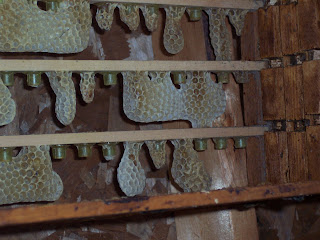 Last summer (2008), the Elgin, Middlesex and Oxford Bee Association had a meeting at Bill Ferguson's apiary in Hensall Ontario(http://www.fergusonapiaries.on.ca/).
Last summer (2008), the Elgin, Middlesex and Oxford Bee Association had a meeting at Bill Ferguson's apiary in Hensall Ontario(http://www.fergusonapiaries.on.ca/).The weather cooperated beautifully and we spent part of the day touring a few of his 700 hives.
Bill breeds and sells Buckfast queens and he showed us his queen rearing operation.
His wife works in the small shack in the bee yard where she selects bee larvae to place inside the little starter cups that will be placed inside his nucs.
I watched while she used a pen-like instrument with a goose feather tip to gently lift a clump of royal jelly with a bee larvae into the little cups.
She commented that if she touches the larvae at all by accident then they don't use it.
 These starter cups (this is a term I made up because at the moment I can't recall what they should be called) will be created into supercedure cells by the bees inside the nucs.
These starter cups (this is a term I made up because at the moment I can't recall what they should be called) will be created into supercedure cells by the bees inside the nucs. The peanut shaped large supercells are larger than a cell for a regular worker bee--that's to make room for the queen's bigger abdomonen.
 As you can see from the photos, Bill creates these really cute "mini nucs" that he uses to raise his queens.
As you can see from the photos, Bill creates these really cute "mini nucs" that he uses to raise his queens.The gals in our group (myself included) thought these little Barbie doll size hive boxes were very sweet, especially with the pink and purple paint.
They use a small piece of wax comb as a starter strip for the bees to build their comb on.
Inside the mini nuc Bill puts a Styrofoam cup with sugar water for the bees as a built in feeder.
 I enjoy the interesting colours that beehives were painted with. A beekeeper confessed to me that the colours are usually whatever paint is on sale at the paint store.
I enjoy the interesting colours that beehives were painted with. A beekeeper confessed to me that the colours are usually whatever paint is on sale at the paint store.The honey house was a real commercial operation with equipment for large beekeeping operations complete with a warm room to help keep that honey flowing.
It was a hot and sunny day and the bees were happy to be flying about their business gathering pollen and nectar.
There was some speculation as to what exactly was going on, whether they were actually balling the queen or whether they were outside the hive because they'd been irritated by a predator such as a skunk.
It was a very interesting day and I enjoyed an opportunity to see a larger beekeeping operation.





No comments:
Post a Comment